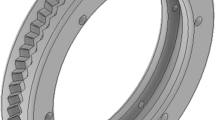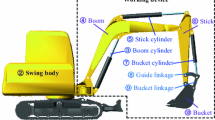Abstract
Electrostatic flocking technology has been widely used, but there are few theoretical studies on the flocking process. In this paper, the key factors affecting the motion of the flock are investigated by analyzing the dynamics of the flock in an electrostatic field. The obtained equation of motion is solved using MATLAB. The influence of flock specification on the rotation and translation process is analyzed. At a constant electric field intensity, the rotation time is linearly positively correlated with the flock’s linear density; the maximum translational velocity is linearly positively correlated with the flock length-to-diameter ratio; and the minimum plate distance is linearly positively correlated with the flock’s linear density. The flock’s maximum translational velocity is proportional to the electric field intensity, and the change in the electric field intensity does not affect the rotation time and the minimum plate distance. The paper also provides the minimum plate distance of eight kinds of nylon flock under the electric field intensity of 50 kV/10 cm. Based on the calculation results, it is suggested that the flocking test first calculates the minimum plate distance based on the flock’s linear density. Then the optimal electric field intensity should be determined according to the flocked fabric’s flocking effect and fastness.
















Similar content being viewed by others
Data Availability
The data are available from the authors upon reasonable request.
References
F.A. Woodruff, Developments in coating and electrostatic flocking. J. Coat. Fabr. 22, 290–297 (1993)
A. McCarthy, R. Shah, J.V. John, D. Brown, J.W. Xie, Understanding and utilizing textile-based electrostatic flocking for biomedical applications. Appl. Phys. Rev. 8, 041326 (2021). https://doi.org/10.1063/5.0070658
Z.Q. Ye, J.B. Xu, J.K. Ma, R. Sun, X.L. Zeng, F. Deng, P.P. Xin, L. Zhang, Aligned-carbon-fibre/silicone-rubber composite with high thermal conductivity fabricated by double-stacked electrostatic flocking method. 21st Int Conf Electron Pack Technol (2020). https://doi.org/10.1109/ICEPT50128.2020.9202515
Z.F. Yu, S. Wei, J.D. Guo, Fabrication of aligned carbon-fiber/polymer TIMs using electrostatic flocking method. J. Mater. Sci.: Mater Electron. 30, 10233–10243 (2019). https://doi.org/10.1007/s10854-019-01360-7
K. Uetani, S. Ata, S. Tomonoh, T. Yamada, M. Yumura, K. Hata, Elastomeric thermal interface materials with high through-plane thermal conductivity from carbon fiber fillers vertically aligned by electrostatic flocking. Adv. Mater. 26, 5857–5862 (2014). https://doi.org/10.1002/adma.201401736
M.R. Li, L.M. Qin, K.T. Ou, Z.Y. Xiong, H.Y. Zheng, Y.Y. Sun, Electrostatic flocking MnO2 nanofiber electrode for long cycling stability supercapacitors. Int. J. Energ. Res. 46, 7946–7956 (2022). https://doi.org/10.1002/er.7692
X.Y. Xu, K. Wang, H. Guo, G.H. Sun, R.R. Chen, J. Yu, J.Y. Liu, C.G. Lin, J. Wang, Zwitterionic modified electrostatic flocking surfaces for diatoms and mussels resistance. J. Colloid. Interf. Sci. 588, 9–18 (2020). https://doi.org/10.1016/j.jcis.2020.12.036
E. Gossla, A. Bernhardt, R. Tonndorf, D. Aibibu, C. Cherif, M. Gelinsky, Anisotropic Chitosan scaffolds generated by electrostatic flocking combined with alginate hydrogel support chondrogenic differentiation. Int. J. Mol. Sci. 22, 9341 (2021). https://doi.org/10.3390/IJMS22179341
T. Takeshita, M. Yosihda, A. Ouchi, A. Hinoki, H. Uchida, T. Kobayashi, Development of multi-lead ECG measurement wear using electrostatic flocking technology. ICEP-IAAC (2018). https://doi.org/10.23919/ICEP.2018.8374690
M. Zhou, S.X. Zhai, T.T. Song, H. Zhao, Z.Z. Fan, F.Y. Ge, Y.P. Zhao, B. Xu, Z.S. Cai, Chemically and physically modified flame-retardant silicone-acrylic emulsion adhesive for electrostatic flocking. J. Inorg. Organomet. 11, 30 (2020). https://doi.org/10.1007/s10904-020-01659-7
Z.M. Zhang, Study on the preparation and properties of carbon black masterbatches for nylon 6 fibers. J. of Silk. 60(4), 44–50 (2023). https://doi.org/10.3969/j.issn.1001-7003.2023.04.007
X.H. Zhang, B. Yang, Y.H. Zhao, J.J. Su, Effect of production process of magnetic induction polyamide 6 fiber on its properties. Adv. Text. Technol. 30(4), 89–93 (2022). https://doi.org/10.19398/j.att.202108015
B.L. Liu, X.Y. Li, Y.G. Li, Structure and properties of nano-Zno modified PA6 fibers. J. of Silk. 59(8), 30–35 (2022). https://doi.org/10.3969/j.issn.1001-7003.2022.08.005
L.F. Liu, H. Xie, L.D. Cheng, J.Y. Yu, S.Z. Yang, Optimal design of superfine polyamide fabric by electrostatic flocking technology. Text. Res. J. 81(1), 3–9 (2011). https://doi.org/10.1177/0040517510376269
B.I. Bobkov, M.I. Glazov, The electrostatic field in the charging dynamics and motion forms of fibers (Textile Industry Press, Beijing, 1983), pp.40–43, 95
Q. Zhang, Y. Xu, Motion laws of fibers in an electric field: first report—motion equations and experimental methods. J China Text Univ. 13(3), 9–18 (1987)
H.Q. Liu, Y.L. Zhao, Concise basic physics volume 1 mechanics and thermology, 2nd edn. (Wuhan University Press, Wuchang, 2000), pp.177–212, 213
M.F. Jiang, X.Z. Feng, L. Chen, A brief introduction to physics (Soochow University Press, Suzhou, 2017), pp.17–19
T.T. Bypavlov, Aerodynamics of textile processes and equipment (Textile Industry Press, Beijing, 1988), pp.14–15
Acknowledgements
The authors thank the Natural Science Foundation of Zhejiang Province of China for its support (LY21E030020, LGG22E030011).
Author information
Authors and Affiliations
Corresponding author
Ethics declarations
Conflict of Interest
The authors declare that there is no conflict of interest.
Rights and permissions
Springer Nature or its licensor (e.g. a society or other partner) holds exclusive rights to this article under a publishing agreement with the author(s) or other rightsholder(s); author self-archiving of the accepted manuscript version of this article is solely governed by the terms of such publishing agreement and applicable law.
About this article
Cite this article
Pan, X., Huang, Z., Jin, W. et al. Calculation of Minimum Plate Distance in Electrostatic Flocking Process Based on Dynamics Research. Fibers Polym 25, 383–393 (2024). https://doi.org/10.1007/s12221-023-00420-4
Received:
Revised:
Accepted:
Published:
Issue Date:
DOI: https://doi.org/10.1007/s12221-023-00420-4




